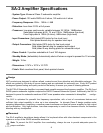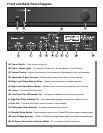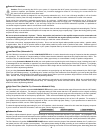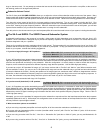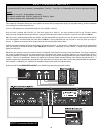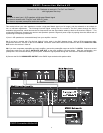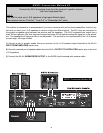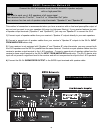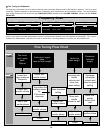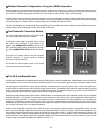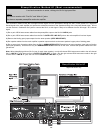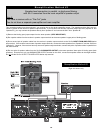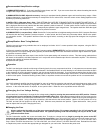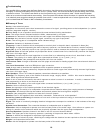
Troubleshooting
If the amplifier fails to operate when the Power Switch is turned on, check the power cord and all the input and output connections
thoroughly. If the front panel status LED is red, the unit is in “protect” mode. This could be caused by incorrect wiring, short circuits,
or excessive volume. Turn off the Power Switch on the front panel for two or more seconds to reset. Double check all speaker
cables to be sure that no small strands are extruding. If the front panel LED indicator fails to illuminate, it is possible that mis-wiring
or an electrical power surge has caused the protection fuse to blow. It must be replaced with one of correct type and value. Contact
your local Authorized NHT Dealer or NHT immediately for assistance.
Glossary of Terms
Active: Uses electrical power.
Amplifier: An electronic device that increases the current of a signal, providing power to the loudspeakers (i.e. power
amplifier, integrated amplifier, receiver).
Barrier Strip: A row of speaker connectors with screw-activated locking mechanisms.
Bass: The range of audio frequencies below 160Hz, characterized by low pitch.
Crossover: An electronic circuit that divides an audio signal into different frequency ranges.
Distortion: Any deviation from the original signal, caused by any type of equipment.
Driver: The moving part of a loudspeaker which radiates energy.
Dynamics: Variations in loudness of sound.
Frequency: A rate of vibration which corresponds to musical pitch in the audio band, expressed in Hertz (Hz).
Full Range: A signal encompassing the entire frequency spectrum, not filtered above or below a certain frequency.
Hertz (Hz): A unit of frequency equal to one cycle per second, used to measure the frequency of a signal or sound.
High-Pass Filter: A filter that passes only frequencies above a certain lower limit; electronically removes low frequen-
cies from a full range signal.
Impedance: A measure of the total opposition to current flow in an alternating current circuit, described in ohms.
In Phase: The polarity of an audio signal when connected as follows: (+) to (+) and (-) to (-).
Integrated Amplifier: Has preamplifier and amplifier built into one chassis.
Interconnect Cable: A length of shielded wire with plugs at both ends for feeding signals from one electronic device to
another.
Line-Level Connection: Low level RCA/phono type connection.
Load: A term used to describe the impedance which a speaker presents to an amplifier.
Low-Pass Filter: A filter that passes only frequencies below a certain upper limit; electronically removes high frequen-
cies from a full range signal.
Main Speakers: Front L & R channel speakers, sometimes referred to as satellites.
Midrange: The frequency span of the middle of the audio range, roughly 160Hz - 1300Hz. Also used to describe the
driver which reproduces these frequencies.
Ohm: A unit of electrical resistance; that which opposes an electric current in a conductor. In audio, a measure of the
load presented by a device to an electrical source.
Out-of-Phase: The polarity of an audio signal when connected as follows: (+) to (-) and (-) to (+).
Passive: Uses no electrical power.
Phase: An expression of the relative polarities of two identical signals.
Power Handling: The ability of a loudspeaker to operate without distortion when given varying amounts of wattage.
Preamplifier: An electronic device that selects sources and passes line-level signal to amplifier.
Receiver: Has preamplifier, amplifier and tuner built into one chassis.
Satellite: Front L & R speakers when used with a subwoofer. Referred to as “main speakers”.
Sensitivity (same as efficiency): A measure of how much of the input electrical energy is converted into sound ener-
gy, measured in decibels.
Signal: The series of continually changing electrical voltages that correspond to variations in the loudness of the origi-
nal sound.
Speaker-Level Connection: The connection between a loudspeaker and an amplifier.
Subwoofer: A driver designed to operate over the low bass portion of the audio range. Also refers to a system con-
sisting of a woofer and its enclosure which are physically separate from the upper range loudspeakers.
Surround Speakers: Speakers located in the side or rear for surround channel effects.
Treble: The upper part of the frequency spectrum, consisting of frequencies above about 1300Hz.
Tweeter: A small driver designed to reproduce high frequencies.
Watt: A measure of electrical power, combining the voltage with the electrical current required to drive the loudspeaker.
Weight: Low frequencies below 50Hz.
Woofer: A driver designed to operate over the bass portion of the audio range.
16



